

Pioneer ecologist William S. Cooper of the University of Minnesota conducted studies of plant succession beginning in 1916, and was instrumental in the move to have the area protected. Dr. Cooper's first-person account describes his intensive lobbying effort, which met many obstacles but was ultimately successful. Cooper also details his losing fight to prohibit mining in the newly created national monument. Learn more about Glacier Bay's rich Legacy of Research |
Last updated: June 27, 2017
